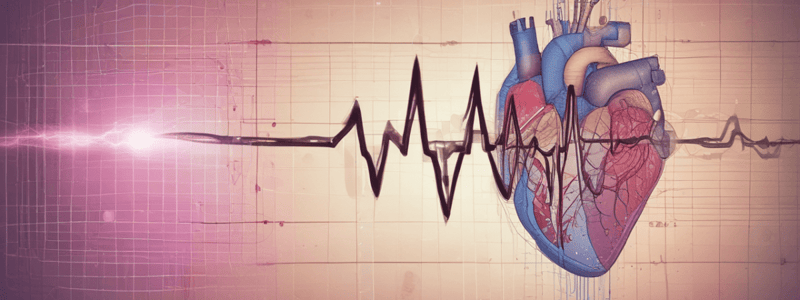Podcast
Questions and Answers
What is an electrocardiograph (ECG) and what does it measure?
What is an electrocardiograph (ECG) and what does it measure?
An electrocardiograph (ECG) is a non-invasive device that measures the electrical activity of the heart, recording the heart's rhythm and electrical impulses.
What type of deflection is produced when an impulse travels towards a positive electrode?
What type of deflection is produced when an impulse travels towards a positive electrode?
Positive or upwards deflection
What is the characteristic of a bipolar ECG lead?
What is the characteristic of a bipolar ECG lead?
One positive electrode and one negative electrode
What does the P wave represent in physiology?
What does the P wave represent in physiology?
In normal sinus rhythm, what is the polarity of the P wave in lead II?
In normal sinus rhythm, what is the polarity of the P wave in lead II?
What is the significance of ST elevation in an ECG?
What is the significance of ST elevation in an ECG?
What is the significance of ST depression in an ECG?
What is the significance of ST depression in an ECG?
What is the characteristic of Atrial Flutter with a 3:1 conduction?
What is the characteristic of Atrial Flutter with a 3:1 conduction?
What is the characteristic of Permanent AF?
What is the characteristic of Permanent AF?
What is the relationship between PAC and Atrial Flutter?
What is the relationship between PAC and Atrial Flutter?
How do you calculate the atrial rate and ventricular rate from an ECG?
How do you calculate the atrial rate and ventricular rate from an ECG?
What is the significance of P wave morphology in an ECG?
What is the significance of P wave morphology in an ECG?
How do you measure the PR interval on an ECG, and what is its significance?
How do you measure the PR interval on an ECG, and what is its significance?
Flashcards are hidden until you start studying
Study Notes
What is an ECG?
- An electrocardiograph (ECG) provides information about the heart's electrical activity.
- It does not provide information about the heart's mechanical activity or blood flow.
Electrodes
- 10 electrodes are used to sense the heart's electrical activity at the skin's surface.
- Electrodes are described as positive or negative.
- Positive electrode: recording, active or exploring.
- Negative electrode: determines the direction in which the positive electrode records.
- Current moves from negative to positive.
- Electrodes are connected to form leads.
Principles of Wave Deflection
- If an impulse travels towards a positive electrode, it produces a positive or upwards deflection.
- If an impulse travels away from a positive electrode, it produces a negative or downward deflection.
- If an impulse travels perpendicular to a positive electrode, it produces a biphasic deflection (half up, half down).
ECG Leads
- 12 leads on an ECG, 10 electrodes.
- An ECG lead records the electrical activity between two electrodes as the current passes through the heart.
- Bipolar: one positive electrode and one negative electrode.
P Wave
- Represents atrial depolarization.
- In normal sinus rhythm:
- Polarity: Upright in lead II, inverted in aVR, biphasic in V1.
- Shape: small and rounded.
- Precedes each QRS complex.
- Consistent shape in the same lead.
- Height: 2mm deep (may be a normal variant in leads III and aVR).
- > 25% of the height of the following QRS.
- Present in leads V1-V3.
R Wave Progression
- R wave is the first upward deflection after the P wave.
- R-wave progression:
- Ventricles depolarize down and toward the LEFT.
- Right-sided leads (V1) negative.
- Left-sided leads (V6) positive.
- The 'progression' means a smooth transition.
- When R>S, it is labeled the transition point.
- Normal transition point: V3-V4.
- Abnormal R wave progression in anterior MI, LVH, RVH, and other conditions.
ST Segment
- Represents no electrical activity – ventricles are depolarized.
- Normally isoelectric (flat).
- Measured from the end of the S wave (J point) to the beginning of the T wave.
- J point defines where the QRS ends & ST segment begins.
- Look for:
- Elevation.
- Depression.
- Shape: concave up (normal), concave down / horizontal (abnormal, more indicative of ischemia / infarction).
- Ischemia can cause ST elevation or depression.
- Depression is more commonly associated with ischemia.
- Elevation is more commonly associated with infarction (STEMI).
Atrial Fibrillation (AF)
- Permanent AF: duration > 1 year, resistant to treatment.
- AF uncontrolled: atrial rate is fast and irregular.
- AF controlled: atrial rate is slow and regular.
Studying That Suits You
Use AI to generate personalized quizzes and flashcards to suit your learning preferences.





